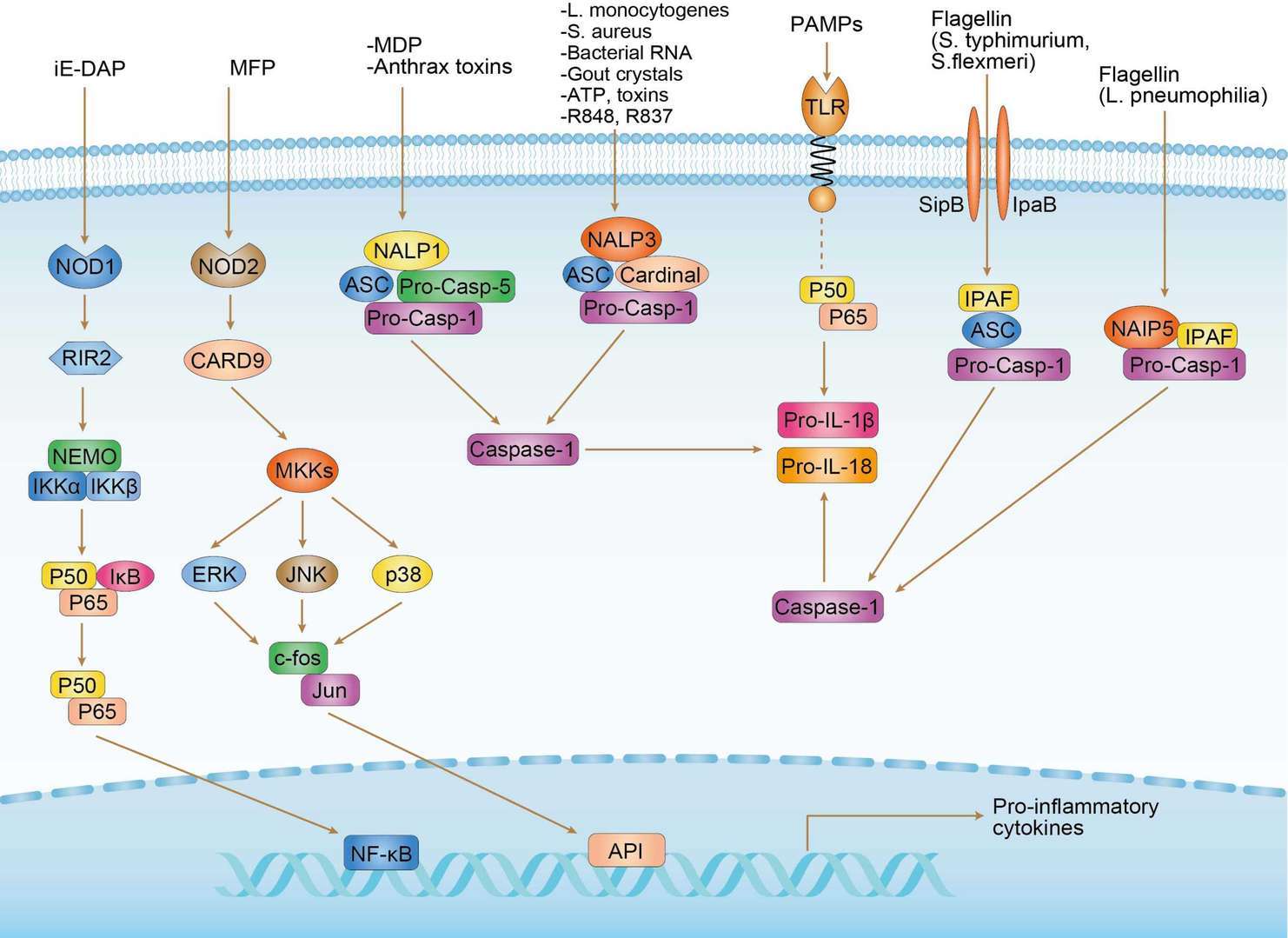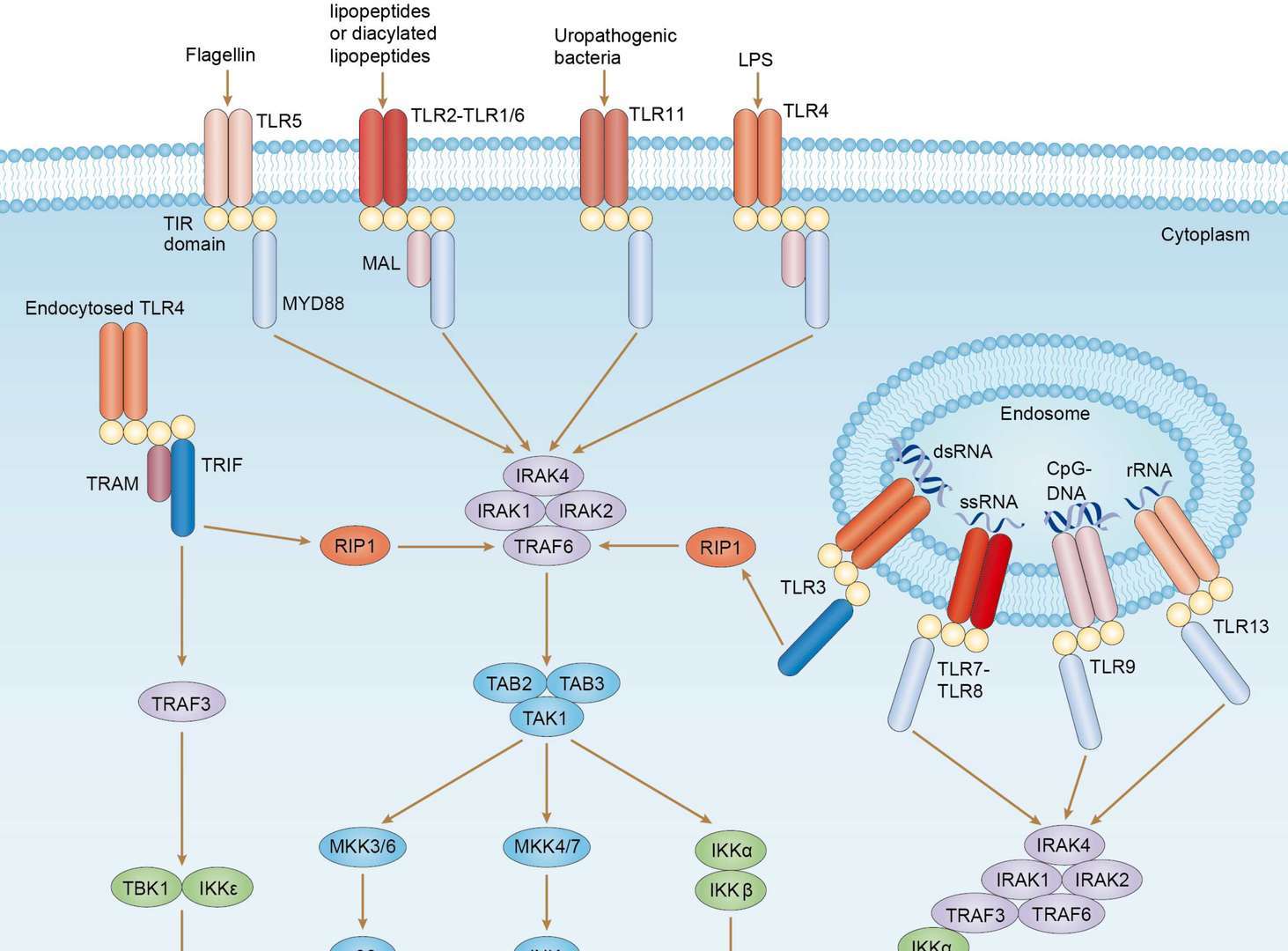Mouse Anti-TLR3 scFv-Fc Chimera (VS-0425-FY7)
CAT#: VS-0425-FY7
The Anti-TLR3 scFv-Fc is a customizable, recombinant fusion protein designed to specifically bind to Toll-Like Receptor 3 (TLR3), an important component of the innate immune system. This product combines a single-chain variable fragment (scFv) with an Fc region to enhance its stability, solubility, and half-life in circulation, making it suitable for various therapeutic and research applications.









Specifications
- Immunogen
- Recombinant human His-tagged TLR3 extracellular domain recombinant protein.
- Host Species
- Mouse
- Type
- Mouse IgG1, scFv-Fc
- Specificity
- Human TLR3
- Species Reactivity
- Human
- Applications
- ELISA, Flow Cytometry, Immunohistochemistry, Inhibition
- Related Disease
- Autoimmune disease, inflammatory disease
Product Property
- Purity
- >95% as determined by SDS-PAGE
- Concentration
- Please refer to the vial label for the specific concentration.
- Storage
- Centrifuge briefly prior to opening vial. Store at +4°C short term (1-2 weeks). Aliquot and store at -20°C long term. Avoid repeated freeze/thaw cycles.
- Shipping
- Ice packs
Applications
- Application Notes
- The optimal dilution concentration is determined by the experiment.
Target
- Alternative Names
- Toll Like Receptor 3; Toll-Like Receptor 3; CD283 Antigen; CD283; IIAE2
- Gene ID
- 7098
- UniProt ID
- O15455
- Long Name
- Toll Like Receptor 3
- Sequence Similarities
- Belongs to the Toll-like receptor family.
- Cellular Localization
- Endoplasmic reticulum membrane; Single-pass type I membrane protein; Endosome membrane; Early endosome
- Post Translation Modifications
- Heavily N-glycosylated, except on that part of the surface of the ectodomain that is involved in ligand binding.
TLR3 signaling requires a proteolytic cleavage mediated by cathepsins CTSB and CTSH, the cleavage occurs between amino acids 252 and 346.
The cleaved form of TLR3 is the predominant form found in endosomes.
Ubiquitinated by TRIM3; leading to recognition and sorting of polyubiquitinated TLR3 by the ESCRT complexes.
Ubiquitinated by ZNRF1 via 'Lys-63'-linked ubiquitin chains; leading to TLR3 lysosomal trafficking and degradation.
Ubiquitinated by RNF170 at Lys-765 via 'Lys-48'-linked ubiquitin chains; leading to TLR3 proteasomal degradation.
Glycosylation at Asn291, Asn52, Asn57, Asn70, Asn398, Asn124, Asn413, Asn196, Asn507, Asn247, Asn252, Asn265, Asn275, Asn636, and Asn662
Modification sites at PhosphoSitePlus
Glycosylation from GlyGen 17 sites, 33 N-linked glycans (10 sites), 1 O-linked glycan (1 site)
- Protein Refseq
- NP_003256.1
- Function
- Key component of innate and adaptive immunity.
TLRs (Toll-like receptors) control host immune response against pathogens through recognition of molecular patterns specific to microorganisms.
TLR3 is a nucleotide-sensing TLR which is activated by double-stranded RNA, a sign of viral infection.
Acts via the adapter TRIF/TICAM1, leading to NF-kappa-B activation, IRF3 nuclear translocation, cytokine secretion and the inflammatory response.
Customer Review
There are currently no Customer reviews or questions for VS-0425-FY7. Click the button above to contact us or submit your feedback about this product.
Submit Your Publication
Published with our product? Submit your paper and receive a 10% discount on your next order! Share your research to earn exclusive rewards.
Related Signaling Pathways
Downloadable Resources
Download resources about recombinant antibody development and antibody engineering to boost your research.
Product Notes
This is a product of Creative Biolabs' Hi-Affi™ recombinant antibody portfolio, which has several benefits including:
• Increased sensitivity
• Confirmed specificity
• High repeatability
• Excellent batch-to-batch consistency
• Sustainable supply
• Animal-free production
See more details about Hi-Affi™ recombinant antibody benefits.
Datasheet
MSDS
COA
Certificate of Analysis LookupTo download a Certificate of Analysis, please enter a lot number in the search box below. Note: Certificate of Analysis not available for kit components.
Protocol & Troubleshooting
We have outlined the assay protocols, covering reagents, solutions, procedures, and troubleshooting tips for common issues in order to better assist clients in conducting experiments with our products. View the full list of Protocol & Troubleshooting.
See other products for "TLR3"
Select a product category from the dropdown menu below to view related products.
| CAT | Product Name | Application | Type |
|---|---|---|---|
| MOB-1476z | Mouse Anti-TLR3 Recombinant Antibody (clone 40D4) | WB, ICC, IF, IHC, IP, FuncS | Mouse IgG1 |
| MOB-0272MC | Rabbit Anti-TLR3 Antibody | WB, FACS, IHC-P | |
| MOB-2056CT | Recombinant Mouse anti-Human TLR3 Monoclonal antibody (50D2396.7) | FC, WB | |
| HPAB-0725-CN | Human Anti-TLR3 Recombinant Antibody (HPAB-0725-CN) | ELISA, FC | Human IgG4 |
| HPAB-1034WJ | Mouse Anti-TLR3 Recombinant Antibody (HPAB-1034WJ) | ELISA, FC | Mouse IgG |
| CAT | Product Name | Application | Type |
|---|---|---|---|
| TAB-612CL | Human Anti-TLR3 Recombinant Antibody (TAB-612CL) | ELISA | Human IgG |
| CAT | Product Name | Application | Type |
|---|---|---|---|
| TAB-687CT-F(E) | Mouse Anti-TLR3 Recombinant Antibody; Fab Fragment (TAB-687CT-F(E)) | ELISA, FC, Inhib | Mouse Fab |
| TAB-688CT-F(E) | Mouse Anti-TLR3 Recombinant Antibody; Fab Fragment (TAB-688CT-F(E)) | ELISA, FC, Inhib | Mouse Fab |
| TAB-272CQ-F(E) | Rat Anti-TLR3 Recombinant Antibody; Fab Fragment (TAB-272CQ-F(E)) | ELISA, FC, IHC | Rat Fab |
| TAB-273CQ-F(E) | Mouse Anti-TLR3 Recombinant Antibody; Fab Fragment (TAB-273CQ-F(E)) | ELISA, FC, IHC | Mouse Fab |
| TAB-274CQ-F(E) | Mouse Anti-TLR3 Recombinant Antibody; Fab Fragment (TAB-274CQ-F(E)) | ELISA, FC | Mouse Fab |
| CAT | Product Name | Application | Type |
|---|---|---|---|
| BRD-0589MZ | Chicken Anti-TLR3 Polyclonal IgY | WB | Chicken antibody |
| CAT | Product Name | Application | Type |
|---|---|---|---|
| NEUT-2035CQ | Mouse Anti-TLR3 Recombinant Antibody (clone TLR3.7) | FC, FuncS, Neut | Mouse IgG1, κ |
| CAT | Product Name | Application | Type |
|---|---|---|---|
| MOR-4459 | Rabbit Anti-TLR3 Recombinant Antibody (clone SI553DS) | ELISA | Rabbit IgG |
| CAT | Product Name | Application | Type |
|---|---|---|---|
| HPAB-0725-CN-S(P) | Human Anti-TLR3 Recombinant Antibody; scFv Fragment (HPAB-0725-CN-S(P)) | ELISA, FC | Human scFv |
| HPAB-1034WJ-S(P) | Mouse Anti-TLR3 Recombinant Antibody; scFv Fragment (HPAB-1034WJ-S(P)) | ELISA, FC | Mouse scFv |
| HPAB-1035WJ-S(P) | Mouse Anti-TLR3 Recombinant Antibody; scFv Fragment (HPAB-1035WJ-S(P)) | ELISA, FC | Mouse scFv |
| HPAB-1036WJ-S(P) | Mouse Anti-TLR3 Recombinant Antibody; scFv Fragment (HPAB-1036WJ-S(P)) | ELISA, FC | Mouse scFv |
| HPAB-1037WJ-S(P) | Mouse Anti-TLR3 Recombinant Antibody; scFv Fragment (HPAB-1037WJ-S(P)) | ELISA, FC | Mouse scFv |
| CAT | Product Name | Application | Type |
|---|---|---|---|
| HPAB-1034WJ-F(E) | Mouse Anti-TLR3 Recombinant Antibody; Fab Fragment (HPAB-1034WJ-F(E)) | ELISA, FC | Mouse Fab |
| HPAB-1035WJ-F(E) | Mouse Anti-TLR3 Recombinant Antibody; Fab Fragment (HPAB-1035WJ-F(E)) | ELISA, FC | Mouse Fab |
| HPAB-1036WJ-F(E) | Mouse Anti-TLR3 Recombinant Antibody; Fab Fragment (HPAB-1036WJ-F(E)) | ELISA, FC | Mouse Fab |
| HPAB-1037WJ-F(E) | Mouse Anti-TLR3 Recombinant Antibody; Fab Fragment (HPAB-1037WJ-F(E)) | ELISA, FC | Mouse Fab |
| HPAB-1038WJ-F(E) | Mouse Anti-TLR3 Recombinant Antibody; Fab Fragment (HPAB-1038WJ-F(E)) | ELISA, FC | Mouse Fab |
| CAT | Product Name | Application | Type |
|---|---|---|---|
| VS-0225-XY213 | CytoStream™ Mouse Anti-TLR3 Recombinant Antibody (VS-0225-XY213) | FC | Mouse IgG1, kappa |
| CAT | Product Name | Application | Type |
|---|---|---|---|
| VS-0425-YC530 | Recombinant Anti-TLR3 Vesicular Antibody, EV Displayed (VS-0425-YC530) | ELISA, FC, Cell-uptake |
| CAT | Product Name | Application | Type |
|---|---|---|---|
| VS-0525-XY7303 | Anti-TLR3 Immunohistochemistry Kit | IHC | |
| VS-0525-XY7304 | Anti-Mouse TLR3 Immunohistochemistry Kit | IHC | |
| VS-0525-XY7305 | Anti-Canine TLR3 Immunohistochemistry Kit | IHC |
Popular Products

Application: Neut, ELISA, IF, IP, FuncS, FC, ICC

Application: IP, IF, FuncS, FC, Neut, ELISA, ICC

Application: IF, IP, Neut, FuncS, ELISA, FC, ICC

Application: FC, IP, ELISA, Neut, FuncS, IF, WB

Application: WB, ELISA, Neut, FuncS

Application: ELISA, FC, FuncS
For research use only. Not intended for any clinical use. No products from Creative Biolabs may be resold, modified for resale or used to manufacture commercial products without prior written approval from Creative Biolabs.
This site is protected by reCAPTCHA and the Google Privacy Policy and Terms of Service apply.











 NLR Signaling Pathway
NLR Signaling Pathway
 TLR Signaling Pathway
TLR Signaling Pathway


















